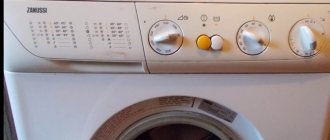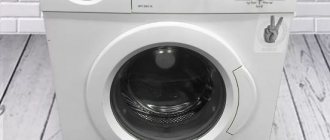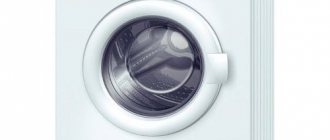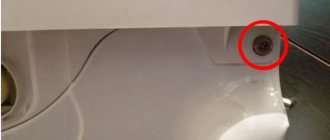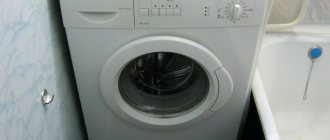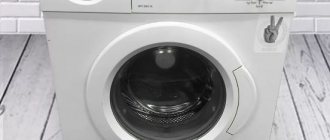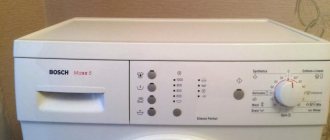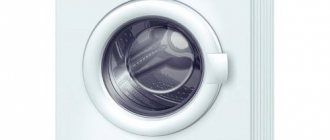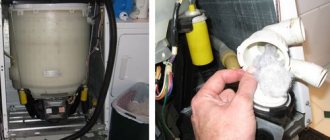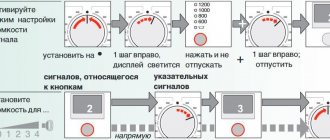SAFETY
1.1. Safety signs
The following pictograms are used in the repair instructions:
| DANGER! Repairs must only be carried out by a qualified electrician! The user may be injured as a result of incorrect repairs! |
| WARNING! |
| Sharp edges: Wear protective gloves. |
| The component is sensitive to static electricity! Please follow the instructions for working with such components. |
1.2. Electrical safety rules
To avoid electrical shock, always follow these instructions:
- If the device is faulty, the housing or frame may be live!
- There may be a risk of electric shock if live components touch metal parts inside the machine! Before starting repair work, disconnect the machine from the electrical network!
- If tests must be carried out while the machine is running while live, always use a differential circuit breaker in such cases!
- The resistance of the protective grounding conductor must not exceed the values specified in the standard! The protective conductor is critical for personal safety and machine function.
- After completing the repair, carry out an inspection in accordance with VDE 0701 or relevant national regulations!
- After completion of the repair, perform a functional check and a leak test.
Please follow these instructions:
- When testing in accordance with VDE 0701 via connector, the heater must be tested for insulation damage to the housing after disconnecting all connectors (relay, pressure switch) and the differential leakage current must be measured on the device!
- When replacing the distributor and drain pump, beware of sharp edges in stainless steel areas.
- Before starting repair work, you should always disconnect the machine from the power source! If tests must be carried out while the machine is running while live, always use a differential circuit breaker in such cases!
Depth of narrow models
Narrow washing machines are those with a width of up to 400 mm. Most often, the maximum load of laundry for these models is up to 4 kg. In some cases, manufacturers lengthen the drum without changing the depth, so the load of laundry can weigh up to 5 kg.
An example of this type of washing machine is Candy CS-34 1051 D1/2. The depth of this model is 340 mm, and up to 5 kg of clothes for washing can be placed in the drum.
These machines have certain disadvantages:
- poor stability and significant vibration,
- the narrow tank prevents the normal rotation of the washing powder, so the quality of the washed items when the drum is fully loaded is lower,
- rapid wear of working elements and shorter operating time as a result of significant vibration,
- increased noise.
The main advantage of automatic machines, in contrast to standard ones, is their shallower depth, which allows them to significantly save space in the room.
INSTALLATION
2.1. Installation
For perfect operation, the appliances must be leveled using the feet. If the device is installed on a plinth, for safety reasons the device must be fixed using the fastening kit No. 080451. If the device is installed under a work surface, then a special metal sheet must be installed instead of the top cover of the device.
2.2. Bay of water
Make sure there is a connection to a central water supply (3/4 inch). The optimal water pressure in the water supply should be in the range of 100-1000 kPa (1 to 10 Bar). The water flow from an open tap should be at least 8 l/minute. For pressures >10 bar, a reducer must be installed.
2.2.1. Version with Aqua Stop valve (optional)
Aqua-Stop is supplied with a hose approximately 1.5 m long. The hose can be extended to 2.5 m with the original extension pipe WZ10130 / WMZ2380 or a longer hose with Aqua-Stop (purchase from service no. 665053, 310 cm). The valve can only be installed as shown in the figure. It cannot be placed in water, however it can be placed in an area with protection class 1 if the device is connected via a 30 mA RCD. The outlet must be in an area with protection class 3 or higher.
Rice. 2 Aqua-Stop comes with hose
2.2.2 Hot water (optional)
Appliances that operate with hot tap water are equipped with two valves. The hot water valve is marked in red; the water temperature should not exceed 60°C.
2.3. Draining
The length of the drain hose can be increased to 4 m (432060 2.20 m), but only if the hose is lying on the floor and has no more than one connection. Devices without Aqua-Stop do not have a container return. The drain hose must not be installed lower than 60 cm.
2.4. Electrical connection
The device can only be connected to a grounded socket. Observe the parameters on the nameplate. The residual current circuit breaker must be rated at 10 A. Connection cable 3 m long (with a grounded plug): no: 481580.
| A | 115 – 150 cm | E | 70 cm |
| B | 175 – 200 cm | F | 130 cm |
| C | 200 cm | G | min. 60 cm |
| D | 145 cm | H | max. 100 cm |
Rice. 3 Connecting the machine to communications
Features of vertical machines
Vertical-type washing machines are good because when loading, the user loads the laundry from above, and not from the side, and therefore protects his back from unnecessary bending.
The dimensions of a top-loading washing machine are standard: most models reach 85 cm in height, and the width and depth are 40 and 60 cm.
A vertical washing machine can easily be turned around in front and placed in a narrow opening, for example, between a washbasin and a wall. She will also stand sideways. Any whim of the owner - and the machine will be installed where it is most convenient. In addition, there will be a lot of free space in the bathroom.
It turns out that the dimensions of a top-loading washing machine allow you to install the washing machine in any corner without encroaching on space.
Vertical washing machines have two significant drawbacks: high cost and a rather small range. If you can find more than 50 horizontal machines in a specialized store, then there will be about 10 vertical models.
The high cost of “vertical machines” is due to the fact that the machines are assembled abroad.
If you are looking at such a model, then you need to take into account that if the machine breaks down, you will also have to order at least spare parts from Europe, which will take longer and be more expensive.
If you decide to integrate a washing machine into your kitchen unit, you will encounter problems. You will have to order special furniture individually for the size of the machine, taking into account the top cover through which the laundry is loaded into the tank.
The upper surface of front-facing machines is often used as additional space for installing household chemicals: powders, conditioners, etc. A vertical model is not suitable for these purposes.
CONTROL
3.1. General management
The device has a program switch, one additional function button, a start button and a display with 3 buttons for selecting the planned start time, temperature and spin speed.
Program progress is indicated by three LEDs.
Rice. 3
3.2. Program selector (1)
The programmer has 16 positions, including the off position. Special programs are also available for selection, a program for wool, synthetics and cotton, and a gentle mode for particularly delicate laundry.
3.3. Extra rinse (2)
Selecting this option activates an additional rinse cycle. At the same time, the program is lengthened.
3.4. Strat/pause + load button (3)
When this button is pressed, the program is started or interrupted.
3.5. LED indicators (4)
The stages of the washing process are highlighted by 3 LED indicators. Ready for use, wash, end of program. During testing, software errors can be identified.
3.6. Buttons for additional functions (5)
Additional function buttons may vary depending on the model.
3.6.1. Maximum spin speed (rpm)
The maximum speed is adjusted (Depending on the program).
3.6.2. Temperature selection (°C)
The washing temperature is determined (Depending on the program)..
3.6.3. Setting the start delay time/Remaining operating time
The start of the program can be delayed by up to 24 hours. During the program, the display shows the approximate time until the end of the program.
Review of narrow washing machine Bosch WLW24K4HOE
It’s good when technology takes on at least some decisions in everyday life. For example, this is what the Bosch WLW24K4HOE washing machine does - it determines what concentration of detergent will be best for specific items and how long to rotate them in the drum.
We do the same: so that users can wash their clothes in peace, and not ask global questions: “How much does she eat?” or “How can I save money on laundry?”, we test this model strictly according to plan.
Characteristics
| Manufacturer | Bosch |
| Model | WLW24K4HOE |
| Type | narrow washing machine |
| Country of Origin | Russia |
| Guarantee | 1 year |
| Life time* | 10 years |
| Type | freestanding |
| Washing class | A |
| Spin class | B |
| Maximum load | 8 kg |
| Maximum spin speed | 1200 rpm |
| Noise level during washing | 51 dB |
| Spin noise level | 73 dB |
| Auto-dosing system for detergents | i-DOS |
| Door canopy | left |
| Leak protection system | AquaStop |
| Imbalance control | Yes |
| Foam control | Yes |
| Hot water connection | No |
| Drum light | There is |
| Remote control | Wi-Fi, Home Connect |
| List of programs | Delicate wash program, Gentle care program, Hand wash wool program, White and colored wash program |
| Additional washing programs and options | i-DOS 1, i-DOS 2, SpeedPerfect, Auto, Outerwear, Spin speed selection, Temperature selection, Jeans, Extra rinse, Finish in, Easy iron, Rinse, Prewash, Down jackets, Mix/Quick, Start/ Pause/Reload, Super 30′/15′, Sensitive |
| Annual electricity consumption (2010/30/EC) | 156 kWh |
| Weight | 79 kg |
| Dimensions (W×H×D) | 598×848×496 mm |
| Depth with door open | 978 mm |
| Network cable length | 1.6 m |
| Water supply hose length | 1.2 m |
| Drain hose length | 1.5 m |
| Retail offers | find out the price |
* Contrary to popular belief, this is not the time limit after which the device will necessarily break down. However, after this period, the manufacturer ceases to bear any responsibility for its performance and has the right to refuse to repair it, even for a fee.
Equipment
The machine is supplied in technological packaging made of polystyrene foam, covered with polyethylene film. Shipping information is printed on the top cardboard cover. There is also a sticker with the model index, serial number, information about the manufacturer and machine-readable data.
In addition to the machine itself with already attached hoses - inlet and drain - the packaging contains decorative plugs for the holes from the transport bolts and a package with documentation: a user manual, quick start instructions and a mandatory sticker with information about energy efficiency.
At first sight
The layout of the machine is traditional: the tray for loading detergents is located on the left, the display with touch buttons is on the right, and the round program selector is in the center of the top panel.
The drum cover is finished in silver metal and black plastic. The outer glazing is made of plastic and decorated with an engraved manufacturer's logo, the inner part is glass. The cover protrudes noticeably, almost three centimeters, beyond the front dimensions of the car - this should be taken into account when planning to move the device through narrow doorways.
The metal side walls are decorated with stamping and look very nice.
The drain and inlet hoses are already installed: the first comes from the upper left corner of the rear wall, the second, equipped with an AquaStop valve, from the upper right. Four transport bolts that hold the drum in the stowed position are combined with plastic holders that secure the hoses.
There are three compartments in the detergent tray: the left one is designed for manual supply of gel, powder or bleach, and the two containers on the right are reserved for the auto-dosing system and are filled through holes closed by folding hatches.
If necessary, the tray can be completely removed by pressing the blue button. By default, the left i-DOS container is intended for conditioner; the right one should be filled with washing gel. But if there is no need for a softener, you can fill both containers with washing gel. This will require additional setup via the mobile app, which we'll cover below.
The pump unit that supplies detergent to the tank is located on the top cover of the tray; it can be removed for cleaning and maintenance.
If you need to change detergents, you can drain them by removing the top cover of the cuvette.
The manufacturer is especially proud of the drum design. It is produced using SoftCare drum technology: seamless, with a unique relief and asymmetrical grips, so the effect on the fabric is selective and delicate. The inner surface of the container is covered with a sinusoidal pattern of round protrusions and paired rows of holes.
The drum is equipped with a backlight that turns on when the door is opened and goes out half a minute after the program starts. Silumin hinges are located on the left; this model does not have the ability to hang the door.
The filter hatch, located in the lower right corner of the front panel, is secured with a latch and opens easily. Behind it are a compartment plug and an emergency drain hose.
According to an established tradition, we partially disassemble the washing machine to demonstrate its rich inner world.
Instructions
The washing machine user manual is a thick, 64-page A5 brochure. The paper is thick, the printing is excellent, there are a lot of drawings.
Unlike the vast majority of manufacturers of large household appliances, which compose a single manual for several product lines at once, Bosh has released its own instructions for this model. Very user friendly.
The document contains detailed and comprehensive information about connecting the machine, preparing it for operation, operation and maintenance. You don’t have to refer to the documentation often: operating the washing machine is intuitive and uncomplicated.
Control
The central part of the program selector is one large black button that turns the machine on and off. Along the perimeter of the selector there is an LED ring that highlights the selected washing program. The handle rotates smoothly, without clicks or resistance.
In the center of the black display, before the wash starts, the water temperature, spin speed and maximum load for the selected mode are displayed. When the machine is running, the display shows the expected cycle time.
The bright white numbers are highly contrasting and easy to read from any angle. Above them are two scales of comparative efficiency of the installed program: the blue one tells about water consumption, and the red one tells about electricity consumption.
At the top of the display there are buttons that include prewash, extra rinse and anti-crease modes (the latter option activates a wash with reduced wrinkle formation - the machine automatically reduces the time and spin speed). The far right button in the top row enables remote control via the mobile app.
In the bottom row we see buttons:
- SpeedPerfect : control of accelerated washing modes. When you select the appropriate program, by pressing the button you can select a thirty- and fifteen-minute cycle.
- Temperature selection : depending on the set mode, values from 20 to 90 °C are available. If desired, water heating can be turned off completely - then a snowflake symbol appears on the display instead of the temperature.
- Selecting the spin speed . Available values are 400, 600, 800, 1000 and 1200 rpm, as well as completely turning off the spin.
- Launch delays . Unlike most washing machines we are familiar with, the Bosch WLW24K4HOE does not set the interval after which the machine will start working, but the time at which the wash should be completed. By successive clicks on the sensor, the value is set from 1 to 24 hours in one-hour increments. A long press of more than 3 seconds on the sensor turns the child lock .
In the table below we show the default values for each wash program and the possible range of manual settings.
| Program | Default water temperature, °C | Possibility of temperature change, °C | Duration of the program | Default spin, rpm | Possibility of changing the spin speed, rpm |
| Cotton | 40 | 0—90 | 3:09 | 1200 | 0—1200 |
| Cotton Eco | 40 | 0—90 | 2:51 | 1200 | 0—1200 |
| Synthetics | 40 | 0—60 | 2:20 | 1200 | 0—1200 |
| Mixed/fast | 40 | 0—60 | 1:19 | 1200 | 0—1200 |
| Wool | 30 | 0—40 | 0:41 | 800 | 0—800 |
| Rinsing | — | — | 0:22 | 1200 | 0—1200 |
| Spin/Drain | — | — | 0:13 | 1200 | 0—1200 |
| Cleaning the drum | — | — | 1:10 | 1200 | 1200 |
| Super 30′/15′ | 30 | 0—40 | 0:35/0:20 | 800 | 0—1200 |
| Down jackets | 40 | 0—60 | 1:37 | 1000 | 0—1200 |
| Delicates/silk | 30 | 0—40 | 0:40 | 600 | 0—800 |
| Jeans | 30 | 0—40 | 1:17 | 800 | 0—1200 |
| Sensitive | 60 | 0—60 | 2:50 | 1200 | 0—1200 |
| Auto | automatically | — | 1:12 | automatically | — |
Two buttons on the left side of the display control the automatic dispensing of liquid detergents: by pressing them you can turn on or off the automatic dosing of washing gel and conditioner. Red indicators next to the sensors light up when the i-DOS option is turned on and blink if the liquid level in the corresponding container is below the minimum.
The button on the right side of the display starts the selected washing scenario. If necessary, you can pause work and open the drum to reload laundry (the latter option is not available in all programs).
Smartphone control
To remotely control the washing machine, the Home Connect (Russia) application is used. At the time of this review, it has about 50 thousand downloads and a very good rating: 4.3 out of 5 possible.
The program is compatible with a large number of household appliances, which is explained when you first launch it.
After a brief introduction, we see the first screen of the application. In addition to the “add appliance” button, the long page contains a fair amount of recommendations on the use of various household and kitchen appliances: recipes, tips and advertising for a healthy lifestyle - unfortunately, exclusively in English.
To add our washing machine to the app, Home Connect requires you to create an account with a verified email address.
The registration procedure is simple. After it is completed, you can proceed to the process of synchronizing the device - to do this you will have to remember the password for the Wi-Fi network.
To sync, the app requires access to the device's location. This permission is reportedly only needed for automatic washing machine detection. After synchronization, you can revoke it - but everyone, of course, forgets to do this.
Despite the permission being issued, we were unable to detect the car automatically. It’s good that the application allows you to select a device in another way: by scanning the QR code from the booklet or by entering the serial number of the device manually.
After identifying the machine, the application provides simple connection instructions and is ready for use in a minute: you can see our device on the Home Connect main page.
The “Control” section almost completely duplicates the functions of the washing machine control panel, providing the user with the same set of built-in programs and washing options.
The list of programs is almost the same as those selected using the selector, except that instead of the “Jeans” mode, the application offers a scenario called “Dark Linen/Synthetics +” with the same temperature mode and the same spin speed.
The names of the options have also been slightly changed: “Anti-crease” is called “Less ironing time.”
The “Easy Start” section offers the same functionality, but in “advisor” mode: the application asks the user questions about the type of laundry being washed, its color, material and degree of soiling, allowing you to select additional options.
Having received answers to five questions, the application recommends launching one of the washing programs already known to us - this can be done with one button.
In the settings section, you can cancel remote control of the washing machine, configure a certain “energy saving manager” (we could not find information about it - it remains disabled), adjust the volume of sound signals and check the network connection configuration.
The most useful section, in our opinion, is managing the iDOS system. Here you can adjust the consumption of washing gel and conditioner, and also choose what will be poured into the second tray of the system: conditioner or washing gel.
The minimum portion of both liquids is 5 ml, the maximum is 200 ml. Note that in this case we are talking about the amount of liquids consumed during washing with a maximum load and the maximum amount of dirt on fabrics: the actual consumption depends on water consumption and the level of its contamination.
When the wash is finished, the application will send a push notification, regardless of how the script is launched: from a smartphone or through the control panel.
The application not only controls washing, but also offers an electronic version of the instruction manual, allows you to read service information about the device, including the full model index, serial and production number of the product, and also provides contact information for technical support.
Exploitation
Before installing the washing machine, unscrew the shipping bolts holding the drum in the “stowed position” (a 13-size wrench is required), remove them along with the fasteners and insert decorative plugs into the bolt holes (included in the kit).
The Bosch WLW24K4HOE connection to communications is standard and does not cause difficulties: the drain hose is connected to the sewer system, and the inlet hose, equipped with an AquaStop valve, is connected to the cold water system.
Once in place, the washing machine should be leveled horizontally by turning the adjustable front feet. To do this, you may need a level and a 17mm wrench.
Before the first use, you must clean the drum from factory contaminants and drain the remaining water used during technical control. It is most convenient to use the program of the same name for this. In the cuvette for manual loading, you need to pour half the standard portion of regular detergent (it is not recommended to use gel or powder for wool or delicate fabrics for cleaning), pour a liter of tap water into it and start the program. After seventy minutes the machine is ready for use.
Operating the device is intuitive and does not require frequent reference to the user manual.
After the program starts, the drum rotates for about a minute without water: this allows the device to distribute the loaded laundry more evenly and eliminate possible imbalances.
The duration of the programs indicated in the documentation corresponds to the maximum load. Like most modern washing machines, it may decrease after the weight is determined. The estimated time is adjusted approximately 15-20 minutes after the start of the scenario. If the laundry is very dirty, the water purity sensor can command the device to top up or rinse additionally. Just below, in the measurements section, we provide a wash cycle timing that illustrates this function.
The iDOS system, which automatically controls the supply of detergents, works only with liquid washing gels and conditioners. Those who are accustomed to using powders for washing will have to change them to products compatible with the system.
The manufacturer's default dosage turned out to be quite sufficient for most of the scenarios that we tested during test operation. It only needs to be adjusted when changing the main detergent. Residents of regions with a high level of mineralization of tap water will probably need to adjust the consumption of washing gel and conditioner at the beginning of operation, but for soft Neva water the factory settings of the machine are ideal.
Detergents are poured from the tank before the water supply to the tank is turned on. The sound of the iDOS system pumps is clearly audible: it is slightly louder than the noise level during washing and is comparable to the volume of an intermediate spin. The dosage of washing gel and conditioner is constant and does not depend on the degree of load or soiling of the laundry: the machine regulates the concentration of detergents, adding water if necessary.
Before testing the autodosing system, we measured the volume of detergent that was added manually, and then compared it with the programmed flow rate. It turned out that the amount usual in our washing scenarios can easily be reduced by almost a quarter. This reduction saves money and is less harmful to the environment. Well, you can finally forget about measuring containers and “my hand trembled - I poured half a bottle.” The iDOS system will take care of the exact dosage.
The automatic detergent dispensing function does not work with all modes. Programs for wool or delicate fabrics that require a special gel or powder do not use the product from the iDOS reservoir - they will have to be loaded into the manual feed compartment.
Where autofeed is set by default, it can be disabled by clicking on the appropriate button. This may be required for sportswear made from membrane fabrics if it is washed on normal cycles, but with special gels and conditioners.
Care
To avoid unpleasant odors coming from the drum, you should regularly run a wash cycle with all-purpose detergent without any laundry. If you frequently wash at a temperature of 60 °C or higher, you have to do this less often, but for those who wash primarily in cold water, the machine itself will remind you of this procedure: for this there is a special indicator on the control panel.
When the mobile app is connected, the machine will notify you when cleaning is required using a push notification.
It is recommended to wash the detergent cuvette when changing gel or conditioner or when it becomes dirty. To do this, remove the tray, remove the pump unit, rinse the container and wipe dry.
The dispenser pump must not be washed in a dishwasher or immersed in water.
Our measurements
For several reviews in a row, we have been evaluating the drum capacity of washing machines to the best of our ability. Of course, in many cases you cannot call it a regular cylinder, but for approximate calculations it is enough to imagine it as such.
The Bosch WLW24K4HOE tank is a cylinder with a radius of 25 cm and a depth of 30 cm. Its volume is 58905 cm³, that is, approximately 58.9 liters.
Traditionally, we monitor the work of the main program with a stopwatch in our hands (Clap mode with default settings) and summarize the data in a table.
| Time until the end of the wash | Time on display | Action | Total water consumption, l |
| 1:48 | 3:09 | Start of rotation | |
| 1:47 | 3:08 | Detergent is poured in, water supply is turned on | 7:0 |
| 1:46 | 3:07 | Add water, start washing | 8,5 |
| 1:26 | 1:08 | The expected duration of the wash cycle has been adjusted, the time on the display has changed | |
| 1:08 | 0:50 | Adding water | 10,7 |
| 0:46 | 0:29 | Drain, spin | |
| 0:35 | 0:16 | Filling with water, rinsing | 12,8 |
| 0:31 | 0:28 | The time on the display has changed again: an additional rinse is required. Drain, spin | |
| 0:27 | 0:24 | Filling with water, rinsing | 24 |
| 0:22 | 0:19 | Drain, spin | |
| 0:17 | 0:14 | Filling with water, rinsing | 35,2 |
| 0:11 | 0:08 | Drain, final spin at maximum speed | |
| 0:00 | 0:00 | Spin completion, drum unlock, beep |
Energy and water consumption
The manufacturer provides information on water and electricity consumption for the main modes in the documentation.
| Program | Amount of water, l | Electricity consumption, kWh |
| Cotton 20 °C | 78 | 0,350 |
| Cotton 40 °C | 78 | 1,100 |
| Cotton 60 °C | 78 | 1,180 |
| Cotton Eco | 50 | 1,040 |
| Synthetics | 55 | 0,680 |
| Mixed/Fast | 45 | 0,610 |
| Delicates/Silk | 35 | 0,190 |
| Wool | 41 | 0,220 |
He warns: actual data may differ from the given values depending on water parameters, room temperature, type, amount and degree of soiling of laundry, voltage fluctuations in the electrical network and selected additional functions. In the course of practical tests, we were convinced that the actual consumption parameters were noticeably lower than the passport ones: we will present the measurement results below.
Spin
We were also interested in the real spin efficiency, which we measure in grams of water per gram of cotton using the formula: (weight of pressed material - dry weight) / dry weight. 10 terry white towels from Ikea with a total weight of about 2 kg were used as reference linen.
| Spin speed, rpm | Remaining water per gram of dry laundry, g |
| 400 | 1,47 |
| 600 | 1,00 |
| 800 | 0,76 |
| 1000 | 0,61 |
| 1200 | 0,53 |
Noise
We measured the volume level in a room where washing machines are often located - the bathroom. The sound level meter was located at a level of 1 m from the floor and at a distance of 1 m from the device, in the center of the front side. We measured not only standard sounds, but also noise when operating the i-DOS system
| Operating mode | Noise level, dBA |
| General noise level in the room | 31 |
| i-DOS | 57 |
| Wash | 48 |
| Drain | 51 |
| Intermediate spin | 56 |
| Rinsing | 48 |
| Final spin 1200 rpm | 59 |
The maximum power consumption of the machine, recorded during practical tests, was 2045 W. In standby mode, the washing machine consumes 0.8 W, and in the off state it consumes about 0.2 W.
Practice tests
To evaluate the main function of the washing machine, we soiled a set of the already mentioned white terry towels, and we used substances that are both common and do not wash well. Washing was carried out using standard programs.
Standard program for cotton, 40 °C
We poured red wine, soy sauce, ketchup, blood and cocoa (each with its own substance) onto a set of five towels.
Cocoa
Ketchup
Soy sauce
Red wine
Blood
After washing on a standard cotton program with default settings, the stains from ketchup and soy sauce disappeared completely, and the stains from red wine, cocoa and blood lightened considerably, but did not completely disappear.
Soy sauce
Red wine
Blood
A wash cycle in the Cotton mode at 40°C required 35.2 liters of water and 0.765 kWh of electricity. The program execution time was 1 hour and 48 minutes.
Result: excellent.
Automatic program
The manufacturer claims that the automatic program of the Bosch WLW24K4HOE is suitable for careful and effective removal of dirt from any fabric. Of course, we did not miss the opportunity to test whether it could cope with stubborn organic stains on white cotton and repeated the experiment with cotton towels and stains from blood, wine, soy sauce, ketchup and cocoa.
Cocoa
Ketchup
Soy sauce
Red wine
Blood
Frankly, we were initially very skeptical. Without even imagining that the relatively short and fully automatic mode would be comparable in efficiency to the long standard cotton program, we loaded up the laundry and prepared for the worst.
The result impressed us. See for yourself:
Red wine
Blood
As in the previous test, ketchup and cocoa stains were removed from white cotton towels without a trace. The traces of soy sauce that the machine failed to cope with in the special mode for cotton last time also disappeared as if they had not been there, and the traces of red wine and blood stains turned out to be much less noticeable.
The automatic program took 1 hour and 12 minutes to complete, requiring 36.6 liters of water and 0.422 kWh of electricity.
Thus, almost half the electricity, a little less water and one and a half times less time were spent on washing in automatic mode.
Result: excellent.
Wool washing mode
There are times when you need to wash furiously, and there are times when you need to wash carefully. So we carried out the next experiment with a woolen blanket weighing a little less than a kilogram. Mode - wool, settings - default (30 °C, spin 800 rpm). Of course, for washing we took a special detergent for wool, which was poured into the removable bath of the manual feed compartment.
Although it was written that the blanket can only be washed by hand, the Bosch WLW24K4HOE did not spoil it: it treated it with care and washed the rather dirty item efficiently. The wool did not mat during the washing process.
During this cycle, 0.239 kWh of electricity and 40.8 liters of water were consumed.
Result: excellent.
Washing a down jacket
In the list of standard programs, we found a mode for washing down jackets: 40 °C and spin at a maximum of 1200 rpm - for such delicate products this speed seemed too high to us. But we decided to trust the manufacturer and wash a rather heavily soiled men's sports jacket filled with natural down, which, judging by the label, is intended exclusively for hand washing.
Miracles, alas, do not happen as often as we would like: we were not too pleased with the results of the wash. The stains were washed off perfectly, but the filler matted and gathered in clumps when the spin cycle was too fast. 1200 rpm may be suitable for synthetic materials, but for natural ones it can be fatal. To save the product, it was necessary not only to dry it in a special machine, but also to sort out the matted clumps of fluff manually
During this wash cycle, 0.447 kWh of electricity and 47.9 liters of water were consumed.
Result: OK, but the default spin speed is too high.
conclusions
We liked the Bosch WLW24K4HOE washing machine due to its high efficiency, resource savings, and convenient and uncomplicated operation. The set of built-in washing scenarios covers, in our opinion, the entire range of needs of the average user, and additional options make the device almost universal.
The “highlights” of the model were the convenient iDOS auto-dosing system for detergents and a very effective automatic washing program, superior in quality even to specialized scenarios.
The disadvantages of the device include the not too high maximum spin speed, the loud operation of the auto-dosing system, and the rather controversial script settings for washing down jackets.
pros:
- convenient function of automatic dosing of detergents and conditioner
- efficient automatic program
- good economy and high efficiency
- possibility of control from a smartphone
Minuses:
- spin speed no higher than 1200 rpm
- The auto-dosing system for detergents is quite loud
- The program for washing down jackets is not gentle enough with clothes
COMPONENTS
4.1. Aqua Stop valve
4.1.1. Functions:
The aquastop is connected to the tap, motionless, and consists of a magnetic valve with a plastic shell. The plastic shell of the aquastop is connected to a double incoming water hose. In the incoming water hose, under the plastic sheath, there is a water hose and an electrical cable to control the solenoid valve. If there is a leak from the hose, water will flow through the water removal hose into the base of the device. The safety system is activated by a float at the bottom of the device. The water leak will be mechanically stopped.
4.1.2 Technical data:
| Rated voltage | 230–240 V |
| Frequency | 50 Hz |
| Resistance | 4.13 kOhm ± 10% |
| Water consumption | 10 l/min ± 10% |
| Water pressure | 1.0–10 bar |
| Maximum inlet water temperature | 25°C |
Rice. 4
| A | Valve | D | Water removal hose |
| B | Aquastop | E | Device base |
| C | Double incoming water hose | F | Float |
4.2. Safety valve Aqua Secure (optional)
4.2.1. Function:
The mechanical valve, which is located in the body of the Aqua-stop safety valve, is connected to the tap. The valve body is connected to the device by a double hose. If the internal hose leaks, drops of water enter the valve body through the double hose. The safety function is activated purely mechanically: when wet, the sponge (B) inside expands, and the piston (A) moves downwards and the flow of water through the valve stops. The inspection eye (C) located on the valve body will be red. The Aqua-stop safety valve block must be replaced entirely, because the sponge does not change in size when it dries, especially since there is already a leak in the internal hose. In addition, at the bottom of the device there is a float with a micro-switch, controlled by the electronics of the device, and when the micro-switch is triggered, the electronics do not allow water to flow into the device.
4.2.2 Technical characteristics:
| Number of ducts | 0.5 – 20 l/min |
| Water pressure | 0.2 - 10 Bar |
| Filling water temperature | 5 – 93°C |
| Air temperature | 5 – 60°C |
| Air humidity | 30 – 95 % |
Rice. 5
| In deactivated state | activated state (triggered) |
| A | Piston |
| B | Sponge |
| C | viewing window |
4.3. Heater (Ten)
4.3.1. Function:
The heating element (A) has two internal fuses (B). Fuses do not change.
Rice. 6
| A | A heating element |
| B | Internal fuses |
| C | NTC (negative temperature coefficient sensor) |
Technical data:
| Rated power | 2000 W |
| Rated voltage | 230VAC |
| Power deviations | +5 % ……. –10 % |
| Resistance | see diagram |
4.4. NTC
4.4.1. Function:
If the NTC value is outside the operating range (open or short circuit), it will continue without heating, without an error message on the display. The test program will display information on the display: “NTC short circuit” - NTC is short-circuited or “NTC interruption” - NTC is open. The NTC is installed into the heater flange and is insulated by heater insulation.
4.4.2 Technical data:
Operating range: –5°C to 103°C
| Temperature (°C) | Resistance (kΩ) |
| 10 | 8.5–10.6 |
| 20 | 5.4–6.5 |
| 30 | 3.5–4.3 |
| 40 | 2.3–2.9 |
| 50 | 1.5–1.9 |
| 60 | 1.1–1.3 |
| 66 | 0.9–1.1 |
| 86 | 0.45–0.55 |
4.5. Drain pump
4.5.1. Function:
The pump is equipped with a thermal fuse. The thermal fuse trips when the current is too high. If the pressure of the pump used in the series is not sufficient, the service can insert the pump up to a pressure height of 1.5 m.
Mat. no.: 144305 (230 V / 50 Hz)
Mat. no.: 142152 (230 V / 60 Hz)
4.5.2. Technical data:
| Rated voltage | 230–240 V |
| Frequency | 50 Hz |
| Resistance | 110–260 Ohm |
| Head height | 1.0 m |
| Performance | 18 l/min |
4.6. Water inflow
Rice. 7
| A | Two-way dispenser | C | Return stream container |
| B | Return stream container | D | Cascade water supply |
4.6.1. Two-way dispenser (A)
Rubber tubes for the pre- and main-wash valves are connected to the two-way detergent dispenser. If both water inlet valves are activated, the two jets of water will collide and the water will flow into the middle compartment of the hopper (drawer), where the conditioner-rinse aid is located.
4.6.2. Cascade water inlet (optional) (D)
1/3 of the incoming water from the pre-wash valve is supplied directly to the top of the hatch.
4.6.3. Ventilation container
A vent container is required to equalize the pressure in the container. If a blockage occurs, the unit cannot draw enough water because the pressure in the transmitter hose increases too quickly.
4.6.4. Drainage ventilation
Thanks to the air gaps, water is prevented from accidentally draining from the device (siphon effect).
4.6.5. Water capacity
Due to the volume of water in the container, the water is blocked with the eco-ball in the drain pipe.
4.7. Oil resistant seal (improved)
Grease-resistant hatch seal, material number: 362172 (with cascade dispenser) and material number: 360000 (without cascade dispenser) can only be installed in the event of an unusually high lubrication load.
Depth of full-size machines
The depth of this type of washing machine varies between 450-600 mm. This technique is not very popular due to the lack of free space in small rooms. But the models have some undeniable advantages:
- stability during spin operation,
- any bulky items are washed well due to the normal circulation of water and washing powder,
- a large volume of stored items - up to 10 kg, this depends on the design of the tank of certain manufacturers' products.
A striking example of this type of machine is the Asko W 6444ALE washing machine with a depth of 590 mm.
DIAGNOSTICS
7.1. Control module
| Complaint | Possible reason | Actions |
| Washing time too long | Factors influencing the duration of the wash cycle: Determining the amount of laundry The device determines a “partial load” (water flow < 65 seconds) or a “full load” (water flow > 65 seconds). The duration of the program depends on the amount of laundry loaded. | Inform the client |
| Device startup with delays. | Power supply voltage and frequency surges. | Inform the customer There should be no surges in voltage or frequency of the supply network. In this case, the machine may be delayed in starting or stop working. |
7.2. No heating
| Complaint | Possible reason | Actions |
| No heating or heating is insufficient. | NTC is faulty. | Check the NTC (according to specifications) and replace if necessary. The heating element may have a short circuit, replace it if necessary. |
7.3. The drum does not rotate
| Complaint | Possible reason | Actions |
| The drum does not rotate. | The belt came off | Check if the belt is positioned correctly. Inform the customer of the effects of overloading on the machine. (If the drum is overloaded, the belt may jump out of place) |
| The carbon brushes have worn out. | Remove the electric motor, check the carbon brushes and replace if necessary. |
7.4. Noises
| Complaint | Possible reason | Actions |
| Tapping sound | The sound is produced due to the design of the shock absorbers. Due to machine overloads, such noise may occur. It is not a malfunction. | Inform the client |
7.5. Washing result
| Complaint | Possible reason | Actions |
| Unsatisfactory washing quality | The amount of detergent, the amount of laundry loaded, the degree of soiling of the laundry, incorrect choice of program, incorrect dosage. | For further information see notice 58300000002975. |
| Insufficient heating or no heating. | Testing the heating circuit using a test program; if necessary, replace the faulty component. | |
| Does not rinse or does not rinse completely (allergy sufferers) | Detergent, loading, program selection, dosage | For further information see repair instructions 58300000002975. |
| Liquid detergent leaks out | Pre-wash program selected | Use a program without prewash or use a dosing cup. |
| A program with a delayed start time has been selected | Use a dosing glass. Follow the instructions in the operating instructions. |
Vertical SM: compact and built-in models
If you think logically, the first thing that comes to mind is that the wider the machine, the more laundry it can accommodate. But the situation is different: capacity has nothing to do with the size of the outer case, all responsibility lies with the volume of the drum.
We invite you to consider compact top-loading washing machines.
“Vertical” machines create much less noise and vibration during washing and spinning than front-type models - it’s all about mounting the drum on two axes.
Vertical machines will be an ideal option for installation in small spaces, since almost all models are narrow in width. But they are not suitable for installation under a sink or sink, as is only possible with small front-facing washers.
So, the advantages, in addition to the compact size, include low vibration levels and quiet operation. There are only two disadvantages: inconvenient installation and the need for constant access to the top cover.
Built-in top-loading washing machines are especially relevant for those who want to save more space in the bathroom or kitchen. Today this method is especially popular - to build in equipment, which means hiding it, fashionable and convenient.
Compact cars are narrow and small-sized models. All manufacturers have a different understanding of compactness, since SMAs are produced with different dimensions and mechanisms. If you are sure that you need a top-loading automatic washing machine, then you have the opportunity to choose everything yourself - from the size to the set of programs.
According to statistics, “vertical” models are superior in service life to front-facing models. In addition, despite their high cost, top-loading washing machines are more convenient to use and place.
Error codes and service programs
8.1. Types of control modules for Bosch Maxx 5 SpeedPerfect series machines
The front panels of the Bosch Maxx 5 SpeedPerfect series machines have two varieties
Module 1 SE(Siemens) + BO(Bosch)
- Small display
- 2 optional buttons
Rice. 19
Module 2 SE(Siemens) + BO(Bosch)
- Large display
- 3 optional buttons
Rice. 20
8.1. Error codes
| Indication | Description | Control / Elimination / Note | |||||
| No: | Program | Test mode | Description of the error | Error manifestation | Possible reason | Elimination | Examination |
| E:00 | X | Internal problem | - there is no possibility to select a program - display indication E:00 on each program | - internal problem in the microcontroller | — activate test mode; if necessary, correct the encoding option | - after activating the test mode on the display o E: └ 8 - memory errors cleared - check the encoding | |
| E:00 | X | No problem | - the device is working properly | - no errors, no errors stored in memory | |||
| E:16 | The door is not closed | - the washing program is stopped - the program can be restarted | - the door is open | Close the door | |||
| E:17 | Water filling time exceeded | - the washing program is stopped - the program can be restarted - the drain pump is turned on | - open the water tap - the program stops, the pump starts after 5 minutes. - restart possible | - check the pump - check the pump connection | |||
| E:18 | Water pumping time exceeded | — the washing program was interrupted - FATAL ERROR, but without draining 90 sec. | — the pump is clogged or faulty - the required level has not been reached — the level sensor hose is clogged - level sensor is faulty | - check the pump - check the pump connection | |||
| E:19 | Heating time exceeded | - heating stopped after 105 minutes - no heating in the next cycle without turning off | - NTC is faulty (out of range) - the heater relay is stuck - the heater is turned on does not correspond to the program progress | — check the heater, wiring - the program will end without heating | |||
| E:20 | Unauthorized heating | - hot steam appears - the pump is turned on - FATAL ERROR | - NTC faulty (out of range) - heater relay stuck - unauthorized heating | - check NTC | |||
| E:21 | - open circuit - unregulated speed - motor does not rotate | — FATAL ERROR + NON-RESETABLE ERROR - washing program interrupted | - short circuit of the motor triac - speed sensor is faulty - software problem | - check the power module - check the wiring - check the motor | |||
| E:22 | - NTC error | - the program runs without heating - the door can be locked all the way | -NTC short circuit -NTC break - wiring | - check NTC | |||
| E:23 | Aqua stop system activated | — the washing program is interrupted - the pump is turned on | - water on the internal base of the device - leakage of the water system - Aqua stop switch is blocked / faulty | - check the water system for leaks - Aqua stop switch - check the electrical wiring | |||
| E:26 | Door lock won't lock | — FATAL ERROR - washing program interrupted — the door is closed, depends on the status — device control is impossible — the indication is fixed on the display | - the door lock is faulty - the lock hook is stuck - the door gets stuck - the window cuff is very hard | — to reset the OFF/ON error. device - check the lock - check the mechanics - check the electrical wiring | Normal mode | ||
| E:34 | Door lock won't lock | — FATAL ERROR - washing program interrupted — the door is closed, depends on the status — device control is impossible — the indication is fixed on the display | - the door lock is faulty - the lock hook is stuck - the door gets stuck - the window cuff is very hard | — to reset the OFF/ON error. device - check the lock - check the mechanics - check the electrical wiring | Normal mode | ||
| E:36 | Door lock circuit defect | FATAL ERROR - washing program interrupted - the door is open, if possible — device control is impossible — the indication is fixed on the display | — Power module is faulty
| - reset OFF/ON error - check the power module - check the wiring | Normal mode | ||
| E:58 | 3D/3G sensor is faulty | Reduced rotation speed | - wiring fault - EMC error - control faulty — 3D/3G sensor is faulty — magnet is not in place (3D only) — 3D/3G sensor software is incompatible | - check the wiring - check the 3D/3G sensor — check the position of the magnet (3D only) - check the controls | |||
| E:59 | 3D/3G sensor: measurement or plausibility error | ||||||
| E:61 | Door lock status is incorrect | FATAL ERROR - washing program interrupted — the door is closed, depends on the status - the pump pumps out water — device control is impossible — the indication is fixed on the display | — the door is not locked, but the status of the closed door is an emergency situation, the door opens manually | — error reset OFF/ON - check the lock — check the mechanism - check the wiring | Normal mode | ||
| E:63 | System error | FATAL ERROR - washing program interrupted - it is possible to open the door — device control is impossible — the indication is fixed on the display | - Functional security error | - reset OFF/ON error - check D-Bus cable - replace power module | Normal mode | ||
FATAL ERROR: The program can be restarted, turn the device OFF/ON
NON-RESETABLE ERROR in user mode: — In the event of an error that cannot be reset in user mode, restarting any program by turning the device OFF/ON is impossible (the error will remain). This error is reset when activating the test program
8.2. Conventions used to describe the operation of the test program
| LED LIGHTS ON |
| LED BLINKING |
| LED OFF |
| Display symbol (wash) LIGHTS |
| Display symbol (spin) FLASHES |
| Display symbol (bar) OFF |
| Rotate the selector to... |
| Press the key... |
| Release the key... |
| Key without LED (Start/Pause) |
8.3. Service programs
| Function | Actions | Indication | Note |
| 8.3.1. Test program | |||
| Activating test mode | — Close the door (Test mode must be activated within 15 seconds from the moment the device is turned on) | ||
| — Set the program selector knob to the OFF position | |||
| 2 sec | — Wait at least 2 seconds. | ||
| — Press and hold the Start/Pause key at the same time, set the switch to position 15, wait for the indication to appear | |||
| No error:/ Error: | — Release the Start/Pause key. | ||
| Note: All errors that are NOT resettable in user mode will be reset when you exit test mode. | |||
| Selecting a test program: | — Move the program selection switch to position 1 (bypassing the OFF position) of the test program. | ||
| 1 | __ | Pos. 1 – PLC (not for service) | |
| 2 | __ | Pos. 2 – not used | |
| 3 | __ | Pos. 3 – Motor | |
| 4 | __ | Pos. 4 – Pump | |
| 5 | __ | Pos. 5–Heater | |
| 6 | __ | Pos. 6 – Hot water valve | |
| 7 | __ | Pos. 7 – Both valves simultaneously | |
| 8 | __ | Pos. 8 – Main wash valve | |
| 9 | __ | Pos. 9 – Pre-wash valve | |
| 10 | __ | Pos. 10 – FLCW (FWW) – AEA (not for service) | |
| 11 | __ | Pos. 11 – FLCI (FIW) – AEA (not for service) | |
| 12 | __ | Pos. 12 – FLCNa (FNaW) – Elabo (not for service) | |
| 13 | __ | Pos. 13 – Automatic test program | |
| 14 | __ | Pos. 14 – FLCL (FLW), FBW (not for service) | |
| 15 | __ | Pos. 15 – Audit line (not for service) | |
| Start of the test program: | Press the Start/Pause key | ||
| Interrupting a test program | Press the Start/Pause key or move the selection switch to another position. After pressing Start/Pause again, the test program can be restarted | ||
| Checking LEDs | When you press the “O1” button in test mode, all LEDs light up | ||
| Exiting test mode: | Set the program selector to position 0 (OFF) or disconnect the machine from power using the power plug | ||
8.4. Functions of service programs
| Function | Actions | Indication | Time(s) | Volume | Note |
Depth of standard models
The depth of this type of machine is 400-450 mm. The filling depends on the volume of the tank and can be up to 7 kg. This machine can accommodate both personal and large clothing, such as a warm jacket or several sets of bed linen. Such washing machines are the most popular among consumers. The equipment takes up relatively little space and can wash a significant amount of laundry.
There are a very large number of standard models, for example, Bosch WLN24242. This washing machine has a depth of 450 mm and a load of 7 kg.

